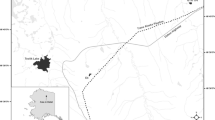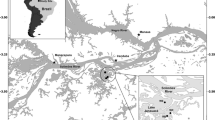Abstract
The effect of methane oxidation in aerobic sediment on oxygen consumption and phosphate flux was investigated in diffusion chambers. The diffusion chambers consisted of two compartments separated by a Teflon membrane. In the upper chamber a thin sediment layer was present and the lower chamber was continuously flushed with gas. The hydrophobic membrane allowed for diffusion of gases from the lower chamber through the sediment layer toward the headspace of the upper chamber. In experiments with a methane oxidation rate of 9.8 mmol m−2 day−1, the oxygen consumption rate increased by a factor of two compared with controls without methane oxidation (8.6 vs 17.7 mmol m−2 day−1). Methane oxidation significantly decreased oxygen penetration depth (2.5–4.0 vs 1.0–2.0 mm). However, despite the shrinkage of the oxidized microlayer, no differences were found in phosphate flux across the sediment water interface. Batch experiments with standard additions of methane revealed that the growth of methanotrophic bacteria contributes to the phosphate uptake of aerobic sediment. From the batch experiments a molar ratio of carbon to phosphate of 45 mol:mol was calculated for the growth of methanotrophs. Results suggest that a decrease in chemical phosphate adsorption caused by a decrease in the oxygen penetration depth could be compensated for entirely by the growth of methanotrophic bacteria.
Similar content being viewed by others
References
Adams DD, Matisoff G, Snodgrass WJ (1982) Flux of reduced chemical constituents (Fe2+, Mn2+, NH4+, and CH4) and sediment oxygen demand in Lake Erie. Hydrobiologia 92:405–414.
Bédard C, Knowles R (1989) Physiology, biochemistry and specific inhibitors of CH4, NH4+, and CO oxidation by methanotrophs and nitrifiers. Microb Reviews 53:68–84
Boström B, Jansson M, Forsberg C (1982) Phosphorus release from lake sediments. Arch Hydrobiol Beih Ergebn Limnol 18:5–59
Broecker WS, Peng TH (1974) Gas exchange rates between air and sea. Tellus 26:21–35
Carlton RG, Wetzel RG (1988) Phosphorus flux from lake sediments: Effect of epipelic algal oxygen production. Limnol Oceanogr 33:562–570
Fenchel T, Blackburn TH (1979) Bacteria and mineral cycling. Academic Press, London
Frenzel P, Thebrath B, Conrad R (1990) Oxidation of methane in the oxic surface layer of a deep lake sediment (Lake Constance). FEMS Microbiol Ecol 73:149–158
Gunderson JK, Jørgensen BB (1990) Microstructure of diffusive boundary layers and the oxygen uptake of the seafloor. Nature 345:604–607
Hanson RS (1980) Ecology and diversity of methylotrophic organisms. Adv Appl Microbiol 26:3–39
Harrits SM, Hanson RS (1980) Stratification of aerobic methane-oxidizing organisms in Lake Mendota, Madison, Wisconsin. Limnol Oceanogr 25:412–421.
Joergensen L, Degn H (1983) Mass spectrometric measurements of methane and oxygen utilization by methanotrophic bacteria. FEMS Microbiol Lett 20:331–335
Keizer P, Buysman M, Cappenberg TE (1991) Sorption and release of phosphorus in a peaty sediment. Verh Internat Verein Limnol 24:722–725
Keizer P, Sinke AJC (1992) Phosphorus in the sediment of the Loosdrecht lakes and its implications for lake restoration perspectives. Hydrobiologia (in press)
King GM (1990a) Regulation by light of methane emissions from a wetland. Nature 345:513–515
King GM (1990b) Dynamics and controls of methane oxidation in a Danish wetland sediment. FEMS Microbiol Ecol 74:309–324
King GM, Roslev P, Skovgaard H (1990) Distribution and rate of methane oxidation in sediments of the Florida Everglades. Appl Environ Microbiol 56:2902–2911
Mortimer CH (1941) The exchange of dissolved substances between mud and water in lakes. I. J Ecol 29:280–329
Mortimer CH (1942) The exchange of dissolved substances between mud and water in lakes. II. J Ecol 30:147–201
Murphy J, Riley JP (1962) A modified single solution method for the determination of phosphate in natural waters. Analytica Chimica Acta 27:31–36
Revsbech NP, Sørensen J, Blackburn TH, Lomholt JP (1980) Distribution of oxygen in marine sediments measured with microelectrodes. Limnol Oceanogr 25:403–411
Rudd JWM, Taylor CD (1980) Methane cycling in aquatic environments. Adv Aquat Microbiol 2:77–150
Sinke AJC, Cornelese AA, Keizer P, Van Tongeren OFR, Cappenberg TE (1990) Mineralization, porewater chemistry and phosphorus release from peaty sediments in the eutrophic Loosdrecht lakes. Freshwater Biol 23:587–599
Sinke AJC, Cornelese AA, Cappenberg TE, Zehnder AJB (1992) Seasonal variation in sulfate reduction and methanogenesis in peaty sediments of eutrophic Lake Loosdrecht, the Netherlands. Biogeochemistry 15:19–37
Sundby B, Anderson LG, Hall POJ, Iverfeldt A, Rutgers van der Loeff MM, Westerlund SFG (1986) The effect of oxygen on release and uptake of cobalt, manganese, iron and phosphate at the sediment-water interface. Geochim Cosmochim Acta 50:1281–1288
Sweerts J-PRA, Cappenberg TE (1988) Use of micro-electrodes for measuring oxygen profiles in lake sediments. Arch Hydrobiol Beih 31:365–371
Sweerts J-PRA, Dekkers TMJ, Cappenberg TE (1992). Methane oxidation at the sediment-water interface of a shallow eutrophic lake (Lake Loosdrecht) and a deep meso-eutrophic lake (Lake Vechten). Arch Hydrobiol Beih (in press)
Tessenow U (1972) Solution, diffusion and sorption in the upper layer of lake sediments. Arch Hydrobiol 4(Suppl 38):353–398
Van Liere L (1986) Loosdrecht lakes, origin, eutrophication, restoration and research programme. Hydrobiol Bull 20:9–15
Van Liere L, Van Ballegooijen L, De Kloet WA, Siewertsen K, Kouwenhoven P, Aldenberg T (1986) Primary production in the various parts of Loosdrecht lakes. Hydrobiol Bull 20:77–85
Yamamoto S, Alcauskas JB, Crozier TE (1976) Solubility of methane in distilled water and seawater. J Chem Eng Data 21:78–80
Author information
Authors and Affiliations
Additional information
Send offprint requests to: A.J.C. Sinke
Rights and permissions
About this article
Cite this article
Sinke, A.J.C., Cottaar, F.H.M., Buis, K. et al. Methane oxidation by methanotrophs and its effects on the phosphate flux over the sediment-water interface in a eutrophic lake. Microb Ecol 24, 259–269 (1992). https://doi.org/10.1007/BF00167785
Received:
Revised:
Issue Date:
DOI: https://doi.org/10.1007/BF00167785




